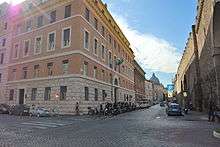Libera Università Maria SS. Assunta
The Libera Università Maria SS. Assunta, often simply abbreviated as "LUMSA" is a private Roman Catholic university founded in 1939 in Rome.
Libera Università Maria SS. Assunta (LUMSA) | |
 | |
| Motto | In fide et humanitate |
|---|---|
Motto in English | In the faith and in the humanity |
| Type | Private |
| Established | 26 October 1939 |
| Rector | Prof. Francesco Bonini[1] |
| Students | 6.017 |
| Location | , |
| Colors | Malachite and white |
| Athletics | UniSport, Centro Sportivo Italiano |
| Website | www.lumsa.it |
 | |
LUMSA was privately founded but belongs to the national Italian network of universities and is therefore able to confer recognised degree and diploma titles which have full legal force. The principal aspects of LUMSA are to be found in its humanist vocation and Catholic orientation. It has a humanist vocation because in a society which is scientifically and technologically advanced there is a growing awareness of the need for ‘wise knowledge’ which is rooted in an authentic idea of man and is able to promote progress for the real good of man and the human community. LUMSA belongs to the national and international scientific research network and has research programmes which operate within certain specific areas: education, the social services, the philosophical, philological and literary sciences, mass communications, and the juridical sciences and economics.
Organization
The university began its life as the "Istituto Superiore di Magistero Maria Ss. Assunta," an educational institute for nuns founded in 1939 by Luigia Tincani (Decree no. 1760 of 26/10/1939). In 1989 it was reconstituted as "Libera Università Maria SS. Assunta" (LUMSA), a university for women. The university was opened to men in 1991.[2]
LUMSA is a private Catholic institution with autonomy at all levels of the university. As an accredited institution, its degrees are considered equivalent to those issued by Italian public universities.
The university is governed by a Council which includes a President, a Rector, two Pro-Rectors, a Director General, and general council members. As of 2016, the President was Cardinal Attilio Nicora.[3]
In 2011, the university was reorganized into its current state, which consists of four departments: the Department of Law, the Department of Law (located in their Palermo branch), the Department of Economic, Political Sciences and Modern Languages, and the Department of Human Studies.[4]
Research
Research and study activities, which are the vital lymph source of every university system, are always characterised in LUMSA by involvement in cultural and scientific dialogue about the great subjects of contemporary debate. Over the years the research activities of the faculties of the university have given rise to a great deal of individual and group research which has been flanked over time by inter-university and international research financed by public and private agencies, by structures providing such services, and by funds provided by the university itself. At the present time research activity is organised around the various research centres of the three faculties.
Teaching
LUMSA University is characterised by the duality of tradition and modernity because it integrates humanistic and classical knowledge with economics, information technology and management. Another characteristic of this university is the emphasis it places on students deserving of financial help. Indeed, the overall level of the fees for the first income band has been made almost the same as that in state universities.
The educational structure of LUMSA is arranged around four divisions. The university offers, through the divisions, a total of ten undergraduate degrees in various social science fields. In post-graduate education, LUMSA offers ten Laurea Magistrale programs and three long-cycle programs in law and primary education, as well as four doctoral programs.[5]
See also
- List of Italian universities
References
- http://www.lumsa.it
- "History". LUMSA Universita (English). Retrieved 1 July 2016.
- "The University Council". LUMSA Universita (English). Retrieved 1 July 2016.
- "LUMSA Departments". LUMSA Universita (English). Retrieved 1 July 2016.
- "Academics". LUMSA Universita (English).
External links
| Wikimedia Commons has media related to Libera Università Maria SS. Assunta. |
- LUMSA University Website (in Italian and English)
- LUMSA International Programme for foreign student (in English)
- Orientation LUMSA
- Degree Courses
- Master LUMSA